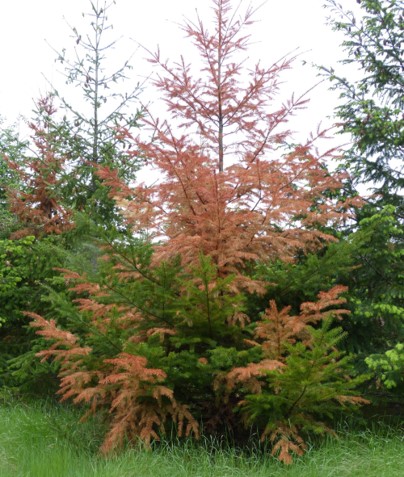Bugs, drought, and fire: what’s the future look like for our forests?
Register for the webinar.

As southern Oregon forestland owners and lovers, we’ve all seen the effects of drought in recent years. It’s a classic tale: trees (most commonly Douglas-fir) that are water stressed and struggling to make it through the abnormally hot, dry season, create the perfect feeding and breeding ground for bark beetles. These insects are able to successfully inhabit a tree because the tree is unable to defend itself due to drought stress. The beetles feed, breed, and leave for another unhealthy and unlucky stand of trees, leaving their former home weak and susceptible to mortality. These dead trees have popped up all throughout the region, triggering a lot of questions from folks asking “why are my trees dying?” and “how can we can fix this issue?”
Unfortunately, there is no one clear answer of how to “fix” the issue. Changing weather patterns and associated forest responses are a complex series of biotic and abiotic factors that we, as land owners and managers, have to work with moving forward. Forest landowners are all searching for a better understanding of strategies and tools available to mitigate the risks from wildfire, drought, insects, and disease, all while sustaining forest productivity and in some cases, profitability.
One key approach to mitigating this uncertainty is to thin to reduce stand densities and increase tree vigor. This typically involves removal of subordinate, small diameter trees, and generates large quantities of biomass that landowners then have to find a market for or utilize. Another uncertainty relates to reforestation after timber harvest: the choice of species and seed zones are a very important decision that must take into account the risks posed by a variable and changing climate. And through all of this, it is essential to maintain appropriate tree density and understory vegetation to mitigate the growing risk for catastrophic wildfire.
Experienced and new landowners alike can agree that these risks and uncertainties are concerning. So let’s not focus on the doom-and-gloom; instead, we should consider what opportunities this new reality provides us.
There are several local resources and strategies available to help forest landowners with these issues, and you can learn about them during the upcoming free webinar series Maintaining a Healthy Forest in an Uncertain Climate, offered by the OSU Extension Service. This six-session webinar series will be offered Wednesdays from 6pm – 7:30pm, beginning June 10th and ending July 15th.
The webinar series will be offered live, giving viewers a chance to ask expert presenters questions in real time. While this series has an ecological focus on southwestern Oregon, landowners from all areas of western Oregon are welcome to attend. There is no cost to attend, however advanced registration is required in order to get the link to view the live series. If you can’t make it to the live presentation, each session will be recorded and available to view online soon after.
The first three webinar sessions will feature presentations by OSU statewide experts in the climate science, forest pathology/entomology, and fire disciplines. The fourth session features a “virtual field trip” where we will virtually tour several small woodland properties and hear from our panel of experts on what risks, vulnerabilities, and mitigation strategies they observed while on the virtual tour. The fifth webinar session will provide information on how to convert woody forest material into biochar. Our sixth and final session will focus on tying all of these concepts together through the use and implementation of a Risk Assessment and Vulnerabilities form. This form will help guide landowners in determining future forest management activities in light of an uncertain climate on any size/type of forested property.



